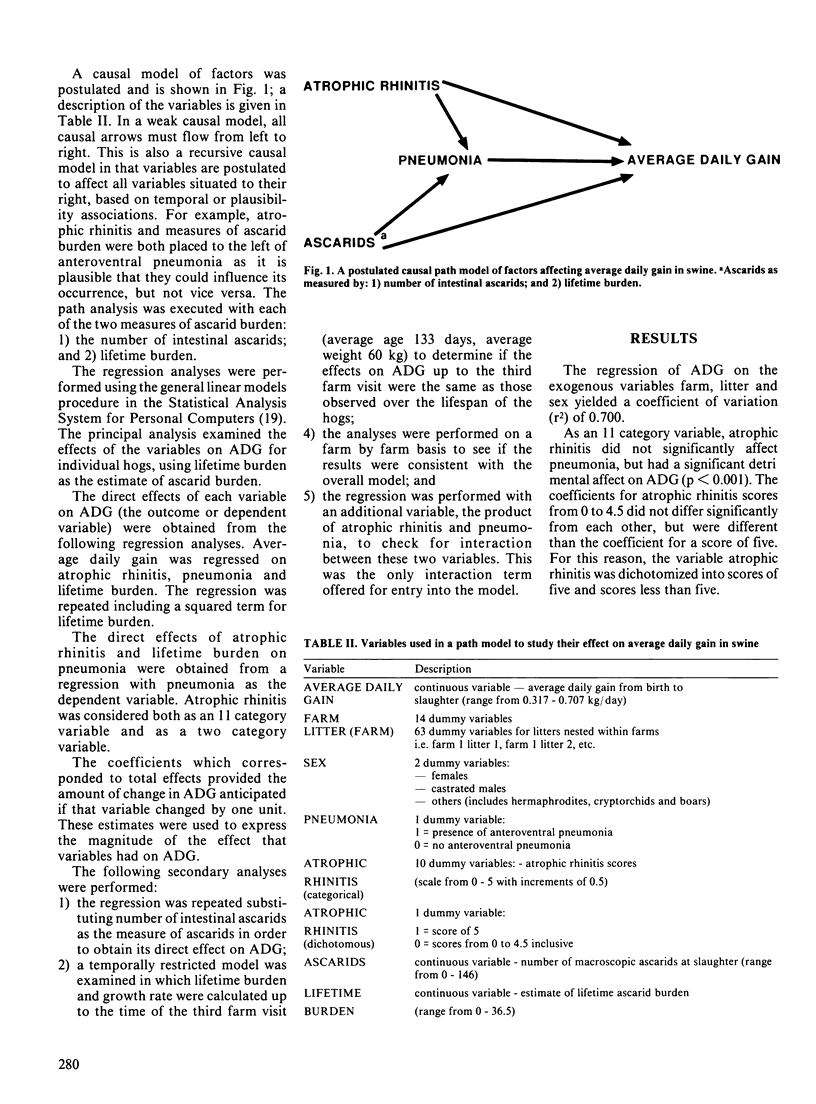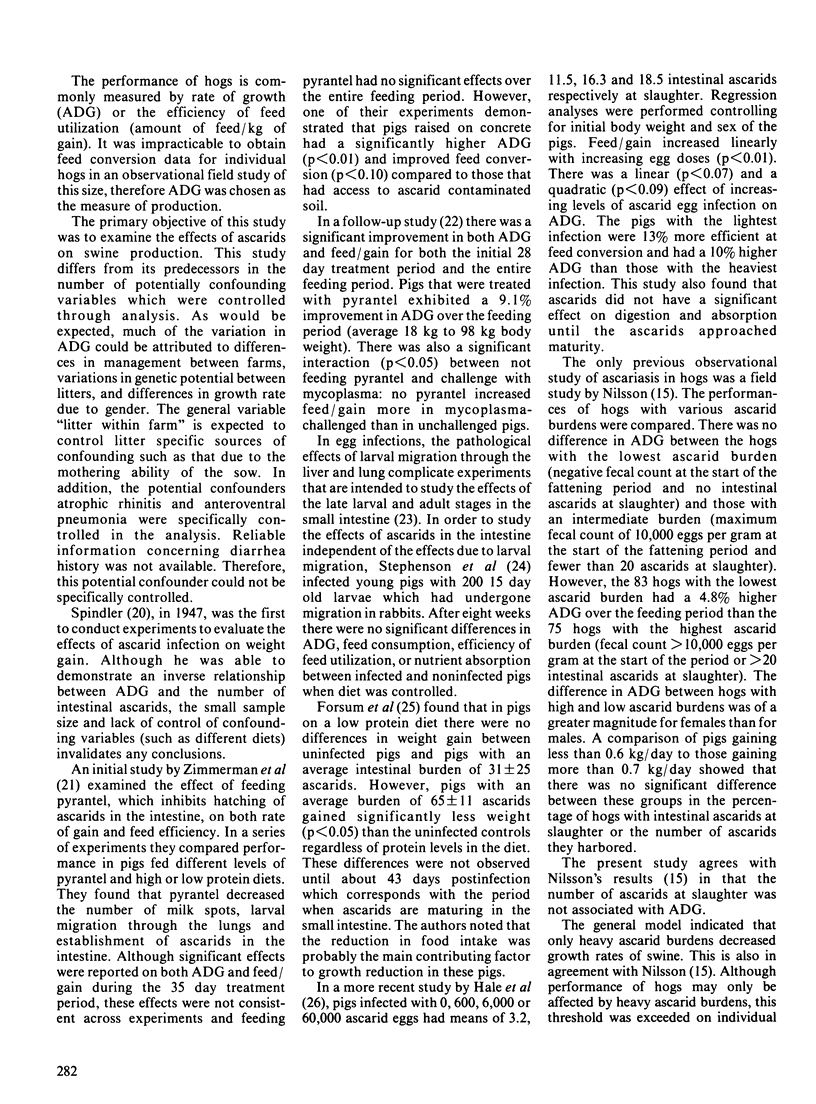Abstract
Growth rates, measures of ascarid burden, and the levels of anteroventral pneumonia and atrophic rhinitis at slaughter were determined for 352 hogs born between March 8 and March 28, 1987 on 15 farms located in Prince Edward Island. Regression analyses were used to determine associations between average daily gain (ADG) and independent variables controlling for sex, farm, and litters nested within farm. The regression model accounted for 75.4% of the variation in ADG. The number of intestinal ascarids at slaughter did not affect ADG. However, the "life-time burden" (a composite measure based on fecal egg counts and duration of infection) was associated with ADG (p less than 0.05) in a quadratic manner. Although heavy ascarid burdens decreased the growth rate of swine, the magnitude of the effect was minimal. The maximum improvement one could expect from reducing the ascarid burden on heavily infected farms would be less than 1%. Severe atrophic rhinitis and the presence of anteroventral pneumonia each had a detrimental effect on ADG (p less than 0.001). The corresponding reductions in mean ADG were 7.7% and 2.8% respectively. There was significant interaction between the effects of atrophic rhinitis and anteroventral pneumonia on ADG (p less than 0.05). Hogs with both anteroventral pneumonia and severe atrophic rhinitis had a 17.6% lower ADG than hogs with neither disease. There is much greater potential for improvement in ADG through control of respiratory diseases than through control of ascariasis.
Full text
PDF






Selected References
These references are in PubMed. This may not be the complete list of references from this article.
- Andersen S., Jorgensen R. J., Nansen P., Nielsen K. Experimental Ascaris suum infection in piglets. Inverse relationship between the numbers of inoculated eggs and the numbers of worms established in the intestine. Acta Pathol Microbiol Scand B Microbiol Immunol. 1973 Dec;81(6):650–656. [PubMed] [Google Scholar]
- Bernardo T. M., Dohoo I. R., Donald A., Ogilvie T., Cawthorn R. Ascariasis, respiratory diseases and production indices in selected Prince Edward Island swine herds. Can J Vet Res. 1990 Apr;54(2):267–273. [PMC free article] [PubMed] [Google Scholar]
- Gaafar S. M., Keittevuti B. Experimental induction of esophagogastric ulcers with inoculations of Ascaris suum eggs in swine. Gastroenterology. 1972 Sep;63(3):423–426. [PubMed] [Google Scholar]
- Hale O. M., Stewart T. B., Marti O. G. Influence of an experimental infection of Ascaris suum on performance of pigs. J Anim Sci. 1985 Jan;60(1):220–225. doi: 10.2527/jas1985.601220x. [DOI] [PubMed] [Google Scholar]
- Häni H., Indermühle N. A. Esophagogastric ulcers in swine infected with Ascaris suum. Vet Pathol. 1979 Sep;16(5):617–618. doi: 10.1177/030098587901600517. [DOI] [PubMed] [Google Scholar]
- Martin S. W., Meek A. H. A path model of factors influencing morbidity and mortality in Ontario feedlot calves. Can J Vet Res. 1986 Jan;50(1):15–22. [PMC free article] [PubMed] [Google Scholar]
- Morrison R. B., Hilley H. D., Leman A. D. The association between pneumonia and atrophic rhinitis in slaughter weight Swine. Can Vet J. 1985 Mar;26(3):95–97. [PMC free article] [PubMed] [Google Scholar]
- Nilsson O. Ascariasis in the pig. An epizootiological and clinical study. Acta Vet Scand Suppl. 1982;79:1–108. [PubMed] [Google Scholar]
- Qureshi S. R., Olander H. J., Gaafar S. M. Esophagogastric ulcers associated with Ascaris suum infestation in swine. Vet Pathol. 1978 May;15(3):353–357. doi: 10.1177/030098587801500310. [DOI] [PubMed] [Google Scholar]
- Stephenson L. S., Georgi J. R., Cleveland D. J. Infection of weanling pigs with known numbers of Ascaris suum fourth stage larvae. Cornell Vet. 1977 Jan;67(1):92–102. [PubMed] [Google Scholar]
- Stephenson L. S., Pond W. G., Nesheim M. C., Krook L. P., Crompton D. W. Ascaris suum: nutrient absorption, growth, and intestinal pathology in young pigs experimentally infected with 15-day-old larvae. Exp Parasitol. 1980 Feb;49(1):15–25. doi: 10.1016/0014-4894(80)90051-x. [DOI] [PubMed] [Google Scholar]
- Straw B. E., Bürgi E. J., Hilley H. D., Leman A. D. Pneumonia and atrophic rhinitis in pigs from a test station. J Am Vet Med Assoc. 1983 Mar 15;182(6):607–611. [PubMed] [Google Scholar]
- UNDERDAHL N. R., KELLEY G. W. The enhancement of virus pneumonia of pigs by the migration of Ascaris suum larvae. J Am Vet Med Assoc. 1957 Feb 15;130(4):173–176. [PubMed] [Google Scholar]
- UNDERDAHL N. R. The affect of Ascaris suum migration on the severity of swine influenza. J Am Vet Med Assoc. 1958 Oct 1;133(7):380–383. [PubMed] [Google Scholar]
- Wilson M. R., Takov R., Friendship R. M., Martin S. W., McMillan I., Hacker R. R., Swaminathan S. Prevalence of respiratory diseases and their association with growth rate and space in randomly selected swine herds. Can J Vet Res. 1986 Apr;50(2):209–216. [PMC free article] [PubMed] [Google Scholar]
- Zimmerman D. R., Spear M. L., Switzer W. P. Effect of Mycoplasma hyopneumoniae infections, pyrantel treatment and protein nutrition on performance of pigs exposed to soil containing Ascaris suum ova. J Anim Sci. 1973 May;36(5):894–897. doi: 10.2527/jas1973.365894x. [DOI] [PubMed] [Google Scholar]
- Zimmerman D. R., Speer V. C., Zimmermann W., Switzer W. P. Effect of pyrantel salts on Ascaris suum infection in growing pigs. J Anim Sci. 1971 May;32(5):874–878. doi: 10.2527/jas1971.325874x. [DOI] [PubMed] [Google Scholar]


